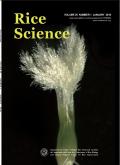非生物胁迫下水稻不同穗位小穗变性生理机制研究进展
IF 5.6
2区 农林科学
Q1 AGRONOMY
引用次数: 0
摘要
水稻产量在很大程度上取决于每个圆锥花序的小穗数,而小穗数是由小穗分化和退化过程决定的。在大圆锥花序的水稻栽培品种中,小穗退化抵消了大圆锥花序的优势,限制了产量潜力。环境胁迫引起的植物新陈代谢紊乱会加剧小穗退化,这一过程的敏感期大约在圆锥花序抽穗前 15-20 d 开始。圆锥花序内的位置差异显著,基部位置的小穗退化率明显高于上部位置。碳氮代谢失衡是非生物胁迫下小穗退化加剧的主要生理基础。碳氮代谢失调会导致能量代谢紊乱和呼吸电子传递失调,从而通过过量的活性氧积累加速幼穗凋亡。蔗糖是小穗发育的主要碳水化合物来源,其顶端优势模式有利于小穗的形成。然而,在非生物胁迫下,抑制蔗糖分解,而不是蔗糖运输障碍,是导致基部圆锥花序位置小穗退化加剧的主要原因。芸苔素内酯和辅助素与小穗的形成有重要关系,可能是顶端优势的介导因素。具体来说,芸苔素内酯能促进蔗糖的积累和利用,从而缓解小穗退化。目前,水稻小穗退化的机理尚未完全揭示,激素、碳水化合物和碳氮代谢对这一过程的共同影响还需要进一步研究。为减少小穗退化,有策略地施用水肥以建立稳定的水稻群体,可增强水稻植株对非生物性胁迫的抗逆性。减少小穗退化的有效方法是在圆锥花序萌发期增加每个小穗的干物质占有量。本文章由计算机程序翻译,如有差异,请以英文原文为准。
Progress on Physiological Mechanisms of Rice Spikelet Degeneration at Different Panicle Positions Caused by Abiotic Stress
Rice yield is heavily reliant on the number of spikelets per panicle, a factor determined by the processes of spikelet differentiation and degeneration. In rice cultivars with large panicles, spikelet degeneration negates the advantages of large panicle and constrains yield potential. Environmental stress-induced metabolic disorders in plants aggravate spikelet degeneration, with the sensitive period for this process commencing approximately 15‒20 d before panicle heading. Notable positional variations occur within the panicle, with significantly higher spikelet degeneration rates at the basal than at the upper positions. An imbalance of carbon and nitrogen metabolism represents the primary physiological basis for aggravated spikelet degeneration under abiotic stress. Impaired carbon and nitrogen metabolism leads to disordered energy metabolism and disrupted respiratory electron transport, which accelerates the apoptosis of young spikelets through excessive reactive oxygen species accumulation. Sucrose serves as the main carbohydrate source for spikelet development, demonstrating an apical dominance pattern that favors spikelet formation. However, under abiotic stress, the inhibition of sucrose decomposition, rather than sucrose transport impairment, predominantly contributes to aggravated spikelet degeneration at the basal panicle positions. Brassinolide and auxin have a significant relationship with spikelet formation, potentially mediating apical dominance. Specifically, brassinolide enhances sucrose accumulation and utilization, thereby alleviating spikelet degeneration. At present, the mechanisms underlying rice spikelet degeneration have not been fully revealed, and the joint effects of hormones, carbohydrates, and carbon and nitrogen metabolism on this process require further investigation. To reduce the spikelet degeneration, the strategic application of water and fertilizer to establish a stable rice population can enhance the rice plants’ resilience to abiotic stress. An effective approach to reducing spikelet degeneration is to increase the dry matter occupancy of each spikelet during the panicle initiation period.
求助全文
通过发布文献求助,成功后即可免费获取论文全文。
去求助
来源期刊

Rice Science
Agricultural and Biological Sciences-Agronomy and Crop Science
CiteScore
8.90
自引率
6.20%
发文量
55
审稿时长
40 weeks
期刊介绍:
Rice Science is an international research journal sponsored by China National Rice Research Institute. It publishes original research papers, review articles, as well as short communications on all aspects of rice sciences in English language. Some of the topics that may be included in each issue are: breeding and genetics, biotechnology, germplasm resources, crop management, pest management, physiology, soil and fertilizer management, ecology, cereal chemistry and post-harvest processing.
 求助内容:
求助内容: 应助结果提醒方式:
应助结果提醒方式:


